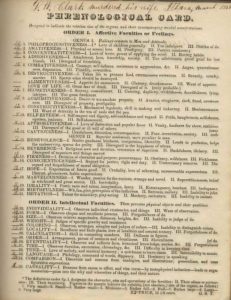
Lorenzo Fowler Completed Cards on His Subjects, Including Lunatics, courtesy Countway Library, Harvard University
The study of head shape and the way it revealed personality and intellect–phrenology–was popular in the U.S. during the 1800s. Three of the most influential figures in this field were two brothers, Orson and Lorenzo Fowler, and their brother-in-law Samuel Wells. The Fowler brothers began their work in the 1830s, and eventually published the American Phrenological Journal. They opened a publishing house called Fowler and Wells and churned out hundreds of short works and phrenological charts, along with casts of heads for students to study.
Mark Twain, who knew plenty about the public’s credulousness and gullibility–having pulled off a number of spectacular hoaxes in his early days as a reporter–decided to expose phrenology for the puff science he thought it to be. Though serious practitioners did not set out to deliberately fool their subjects, Twain believed the whole field mere quackery. During Twain’s European tour in the early 1870s when Lorenzo Fowler was living in England, the two men met.

Phrenology Bust Provided a Three-Dimensional Reference Guide
The reading–in Twain’s words–revealed: “[Fowler] said I possessed amazing courage, and abnormal spirit of daring, a pluck, a stern will, a fearlessness that were without limit, I was astonished at this, and gratified too; I had not suspected it before; but then he foraged over on the other side of my skull and found a hump there which he called “caution.” This hump was so tall, so mountainous, that it reduced my courage-bump to a mere hillock by comparison . . .”
Twain went on, “He continued his discoveries, with the result that I came out safe and sound, at the end, with a hundred great and shining qualities; but which lost their value and amounted to nothing because each of the hundred was coupled up with an opposing defect which took the effectiveness all out of it.” Though Fowler gave the qualified, generic reading Twain expected, Fowler did express one definitive assessment: “However, he found a cavity, in one place; a cavity where a bump would have been in anyone else’s skull . . . . He startled me by saying that that cavity represented the total absence of the sense of humor!”

Mark Twain
Needless to say, Twain was not impressed, though he doubtlessly exaggerated the encounter via the sense of humor Fowler could not find.